| |
|
The
map below is probably the earliest known, that shows Wotton and
the surrounds in fairly accurate representation. The map extends
beyond the area shown here and bears the legend 'Sir John Godwin's'.
At the bottom right the wooded area is called Qwenes Wod and Quens
Wod and this surely means it was first drawn in the reign of a Queen.
The area was the King's Wood from the time of the Norman Conquest
and, apart from the revelation of this map, it has been known as
Kingswood since. Later additions have been made at some reprinting
as 'Grove Wood' and 'Morrels Pond' etc. are in a later script style.
The map is too early for Queen Anne and that would suggest that
the map was drawn in the time of Elizabeth I, perhaps even Mary,
before her. Sir John Godwin, of nearby Winchenden, lived from 1520-1597,
taking in both reigns. The black spot is the entrance to our nursery! |
| |
|
| |
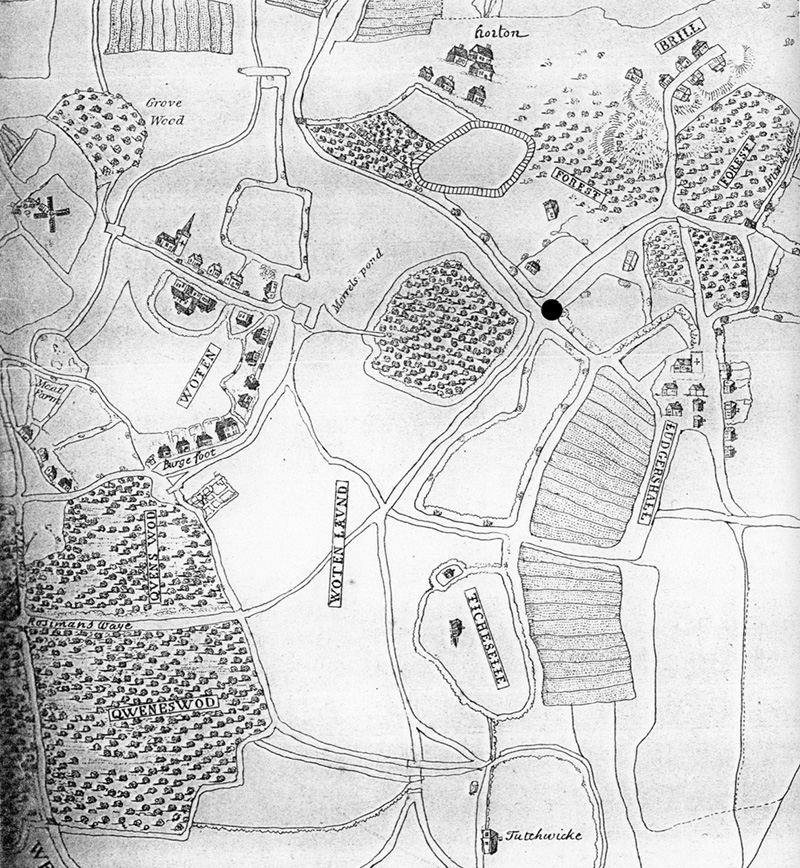
It
might seem like ‘divine providence’ that, probably,
the most interesting and important orchard that has ever compelled
our attention is only ½ mile from the entrance to our nursery.
In
the early 1990s, two friends were out walking in the grounds of
Wotton House, Buckinghamshire, and came across a derelict orchard.
They brought us a variety of apples and pears and we visited this
orchard in haste. We knew little of the important Wotton Estate
at that time, but this orchard was quite obviously ancient and the
historical research followed. No histories mention this orchard,
though it appears on some early maps.
Now,
the thrill of every old orchard is incomplete without a context
and it is there that we must begin.
The
House and Gardens
Wotton
Underwood is recorded in Domesday and there has been a Manor House
there since the twelfth century, and in the hands of the Grenville
family, until the modern age. They later inherited Stowe and the
grounds of both were remade in the 18th century Landscape Movement,
in tandem, to some extent. The village, that was inconveniently
situated, was swept away along with the mediaeval Manor House, though
the Church and some dwellings outside the area of the garden plans
still remain.
The
historical papers of Wotton and nearby villages were bought by the
Henry Huntingdon Library in America as a job lot and many remain
uncatalogued, but some useful information has made its way out.
We can hope for more.
The
Grade 1 listed Wotton House was built between 1704-1714, some say
1717. This second house burnt down in 1820 and was rebuilt a few
years later in a more formal style.
Lord
Richard Grenville, as the 17th century gave way to the 18th, had
already started designs for a fully landscaped garden in the latest
style of the grand landscaping movement. The work was taken over
by London and Wise early on. London was the founder of the famed
Brompton Road Nursery in 1681. Wise became an apprentice there in
the early 1700s. Between them, they were responsible for many famous
garden designs including Blenheim Palace. London died in 1714 and
Wise went on to become Gardener to Queen Anne and George I, designing
and replanting several royal palaces and other gardens. He died
in 1738. Interestingly, they were also the authors of ‘The
Retir’d Gardener’, an influential work that contained
lists of fruit varieties, first published in 1706 and again in 1717.
Though there is no evidence to suggest they included fruit trees
in their landscaping at Wotton, it was a remote possibility, but
one which will seem very remote as our narrative unwinds.
Up
to the middle of the century, the young Lancelot (Capability) Brown
(1716-1783) took over much of the work and added to the designs.
It is believed he went to Wotton before he went to Stowe and Wotton
might have been his first Landscape Garden. It is also thought that
after his work at Stowe Landscape Gardens, after the ownership of
Stowe came to Lord Grenville by marriage, Brown returned to work
further at Wotton. William Pitt the Elder married into the family
and was also said to have helped with the design, sometime in the
early to mid-1700s. It has been suggested by some that grounds development
started in the 1750s but London and Wise were dead by then and this
view is surely wrong. However, we must not get sidetracked into
the fascinating subject of the Landscape Movement and Capability
Brown. The orchard is our focus. The transformation of the grounds
at Wotton was thought by most to be complete by the middle of the
18th century.
|
| |
The
Village
As with most medieval
manors, tenanted properties, both domestic and farm holdings,
littered the area. A map of 1657 shows great detail of the village
at Wotton. This and other maps in the Buckinghamshire County Archives
have been very useful in piecing together the history of this
very old orchard. We are very much interested in what existed
before the village was removed, as will become clear. Since this
orchard was preserved and safe from the plans of London and Wise
and Capability Brown, it might seem 17th century and would appear
to predate the removal of the village. It would make this orchard
the only surviving part of the pre-landscape age of the Wotton
Estate and the oldest part of the current Grade 1 listed House
and Gardens.
This map was dated,
with some uncertainty, at 1657, but it might have been drawn earlier.
It does look, from our experience, of the style of late 16th century
similar maps, as if it was earlier. Another map, dated 1649, might
conversely have been later than this date. The important question
is ‘when was the village removed to make way for the grand
landscaping’? Within the garden plans the entire village,
buildings and all the tenants were removed. Even to the south
of the landscaping the land was cleared and is now within Lawn
Farm (once owned by the Grenvilles) – clear pastures. Some
parts would certainly have been gone just before building of the
new house started in 1704. It rather looks as if it was all cleared
earlier, as Lord Grenville’s garden plans took shape in
his head. There has been a belief in some quarters that the village
was cleared following the Wotton Enclosure Act, variously put
at 1735 and 1743. This was the first or second Private Act for
enclosure in the country. However, the villagers and their holdings
must have been gone by this time as the garden landscaping was
near complete.
The original mediaeval
Manor House is shown on this map of 1657, marked as Grenville’s
Yardes, Barne and House and a short distance to the south and
east of the planned New House. The map has been overmarked by
the garden designers with lines of tree plantings and also shows
the location of the New House. Historic England and all other
histories that we have found say that the location of the original
Manor House is unknown, but this map shows it clearly. There is
an adjacent kitchen garden and two adjacent orchards marked. The
small ‘Old Orchard’ we are considering here was not
needed by the mediaeval manor house and was quite distant. When
the new house was built and Grenville’s kitchen garden and
orchards were eradicated, the ‘old orchard’ would
have been a long walk away for a house maid, having to walk around
the ‘New River’ which had been inserted across the
path between the new House and the ‘old orchard’.
A quarter of a mile or more! Besides which, the new House created
its own orchard and kitchen garden adjacent to the House. This
orchard became part of Lodge Farm and the orchard still existed
until the end of the 1990s. We grafted the trees there and have
them with us. This orchard then gave way to a swimming pool and
tennis court, now in the ownership of Tony and Cherie Blair.
The mediaeval house
and the New House had no interest in the ‘old orchard’.
So whose orchard was it? When was it in existence and why is it
still there?
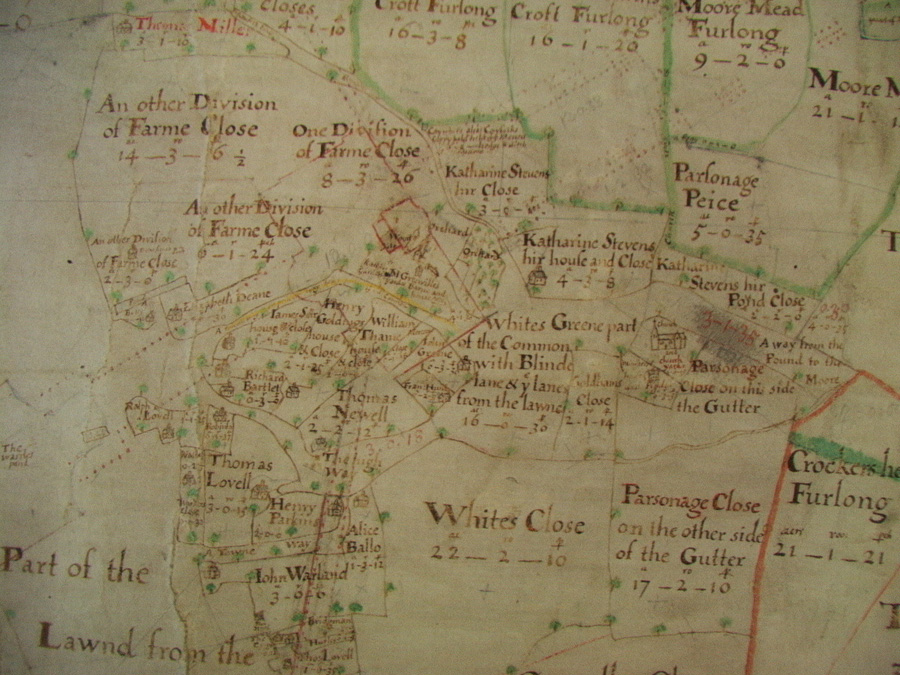
1657 map
|
|
|
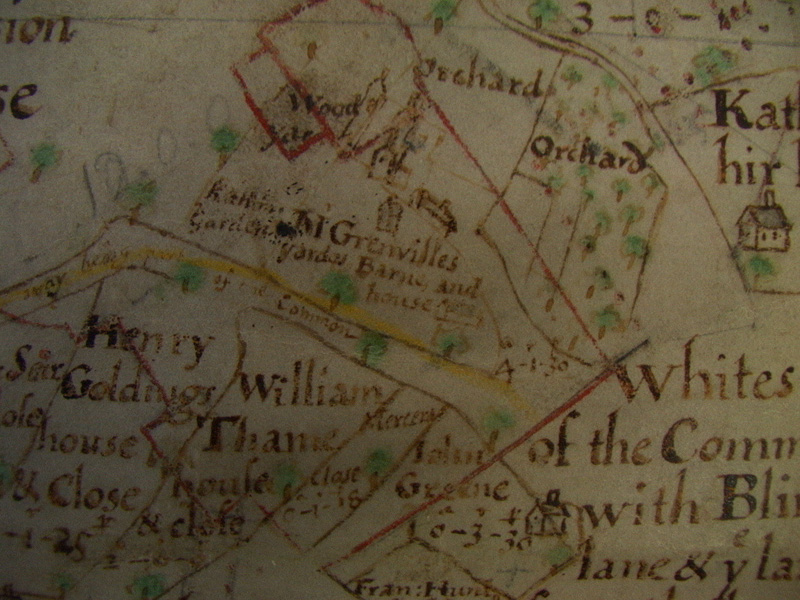
1657 map
The
Old Orchard
On
this 1657(?) map we see the house/garden and wider holding of Thomas
Lovell. It was one of the largest holdings on the map and he must
have been a man of some significance. Note also the ‘The High
Way’ that dips and sweeps past his holding. The top part of
his holding is precisely where the ‘old orchard’ exists
today and the line of The High Way was adopted by the garden designers
as the path that would be followed for the ‘walk’ they
created at the south of the redesigned gardens. Past Thomas Lovell’s
holding, the path would cut south-east and head towards the enlarged
lake, alongside the new avenue of trees. The deviation of The High
Way around Thomas Lovell’s holding was retained.
|
| |
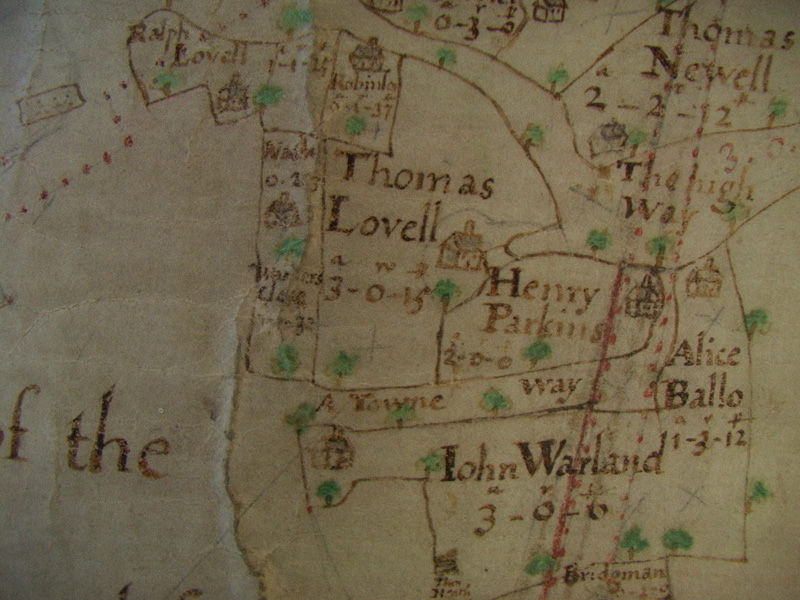
1657 map |
|
We
now look at the 1649 map which seems to be a bit anachronistic,
as it shows far fewer dwellings and holdings than the 1657 map,
as if the 1649 map was later and the 1657 map earlier. Perhaps it
was an earlier map but solely concerned with recording the Closes
and ignoring dwellings and holdings. As with the 1657 map, this
1649 map has been overmarked by the garden designers. There are
three significant features here.
1.
It shows a yellow/orange line added by the garden designers to mark
the path of the Walk on the edge of the reconstructed gardens, following
The High Way, in a detour loop, north of the dwelling marked there,
before heading south east again.
2.
This dwelling is that of Thomas Lovell, as it appears in very much
the same shape and location as the 1657 map, but without the wider
holding he had in the 1657 map. The line of the walk has somewhat
truncated part of Thomas Lovell’s holding, but part remains.
This is ‘the Old Orchard’. If this 1649 map was later
and Thomas Lovell was still living, perhaps he was a valued retainer
for the estate and his dwelling continued to exist post-garden redesign.
His house is outside the redesign, as was ‘The Old Orchard.’
The dwelling has gone and is now part of the clear fields of Lawn
Farm.
3.
The marking of ‘The New River’ might be outside the
awareness of the garden historians of the ages, since it was considered
to have been made in the early to mid 1700s, when the gardens were
redesigned. Yet here it is, marked in the old style of lettering,
on a map dated 1649! Could it be the gardens redesigning commenced
much earlier than has been supposed and if the dates of the maps
of 1657 and 1649 are correct, why was it not shown on the 1657 map?
Surely the 1649 map is later than the 1657 one. Interestingly, the
New River also deviated its path to make allowance for the route
of The High Way and Lovell’s property.
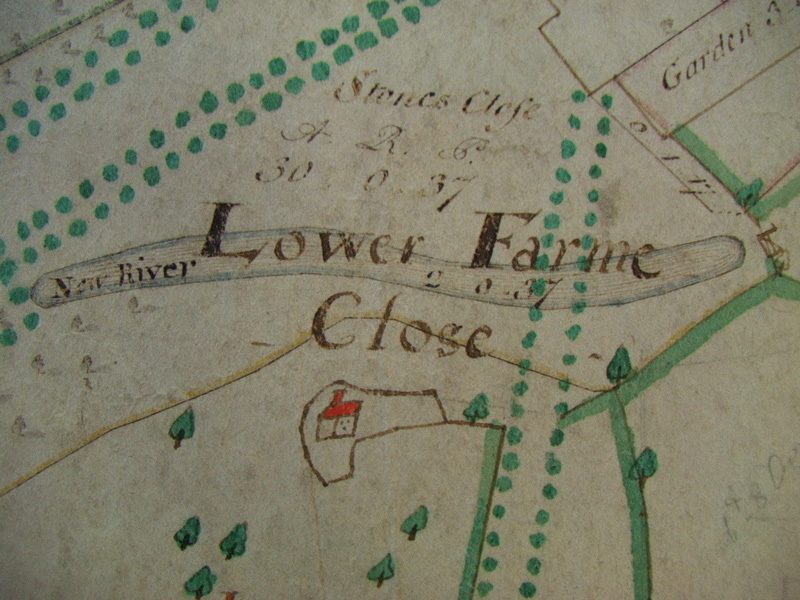
1649 map
|
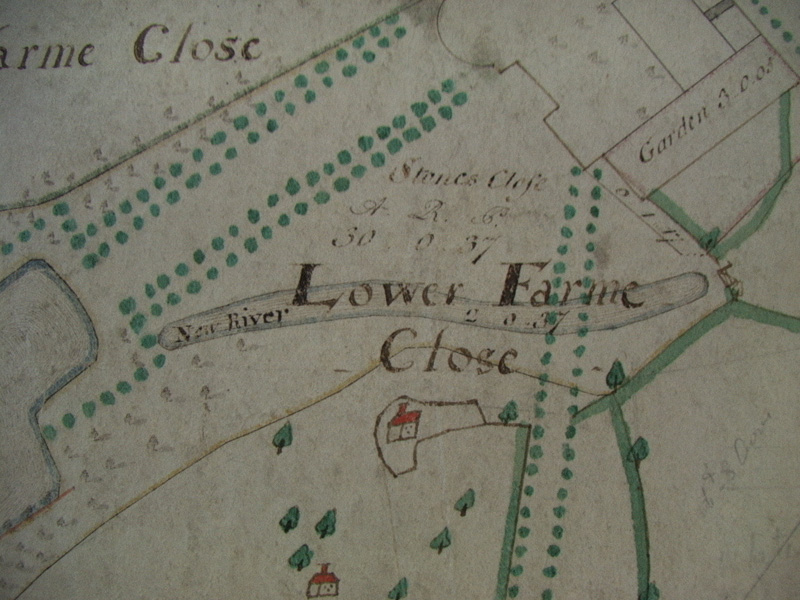
1649 map |
|
| What
Happened Here?
Thomas
Lovell had a small house and yard. He also had an orchard north
of his dwelling, within his larger holding. The various garden designers
used the old ‘High Way’ as the limit of their redesigns
and for the ‘Walk’, which went around and north of Lovell’s
orchard. They trimmed a bit off the northern part of his holding,
but certainly deviated their Walk around the main part of it. They
had no reason to remove the orchard. It was outside of their plans
and probably provided some welcome mature trees to the view, at
a time when most else in the view were mere saplings. Perhaps, being
fruit tree nurserymen, London and Wise could not bear to destroy
an orchard. The orchard had no value for fruit as other new orchards
had already been planted next to the New House. No-one had any interest
in replanting it, or even using it, since now there were no dwellings
for some considerable distance. It was left alone.
A 1798
map (when all landscaping was complete) shows the line of the boundary
of the landscaping and shows the ‘bulge’ around Lovell’s
orchard, but only marks trees sparsely, where they are not part
of the tree avenues.
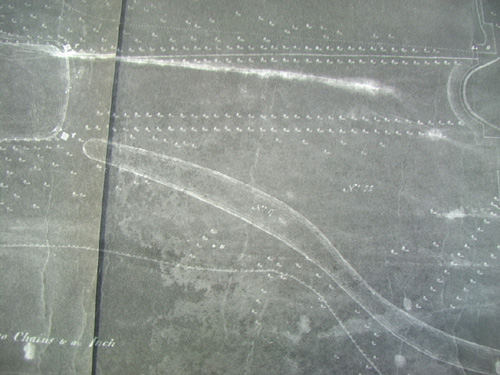
1798 map |
|
|
|
|
| The
map of 1847 shows the redesign complete and the orchard there beyond
the boundary. It is marked 271, which looks to be a denomination
used in the enclosure award a century earlier. Enclosure awards
were often numbered such and this later map might have found value
in using the same key to parcels of land. This orchard is still
part of the Wotton Estate, while, to the south, all is now part
of Lawn Farm.
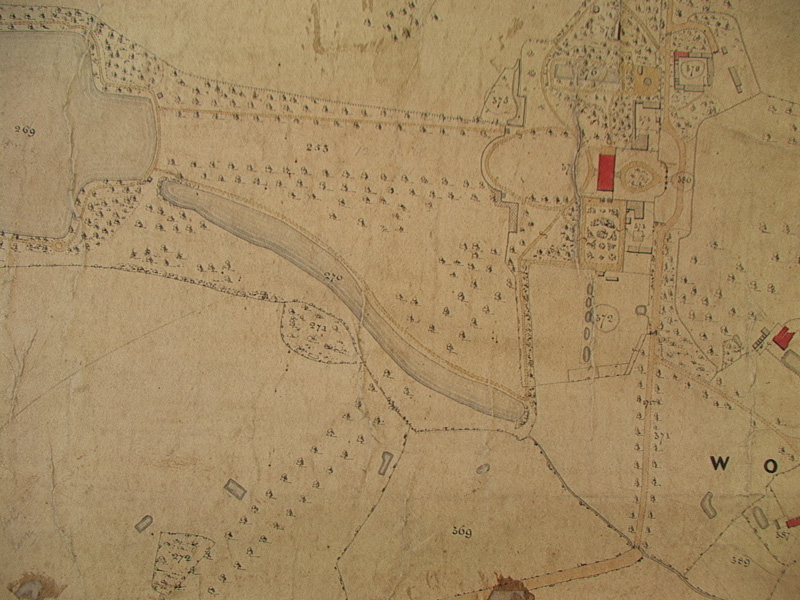
map1847
|
|
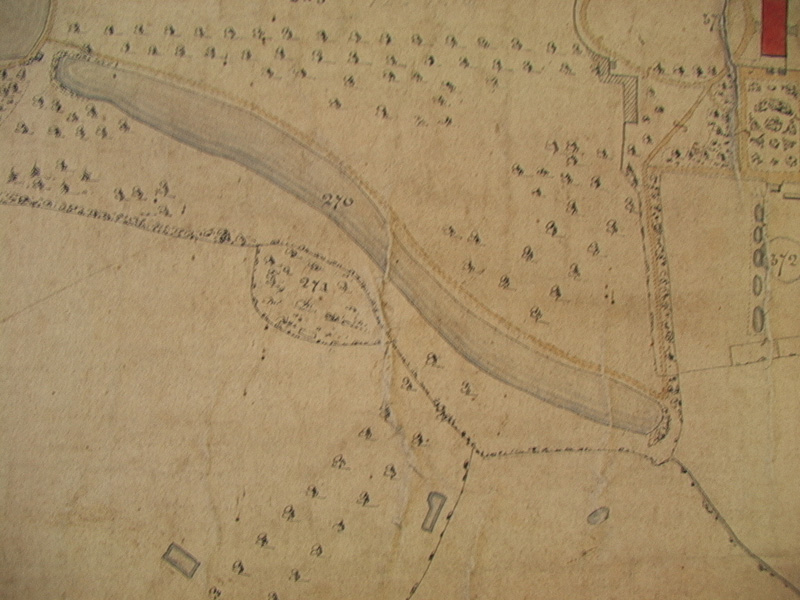
1847 map
|
|
The map of circa 1890,
has now finally acknowledged that there is an ‘Old Orchard’
there and this is much the same size and shape as exists today.
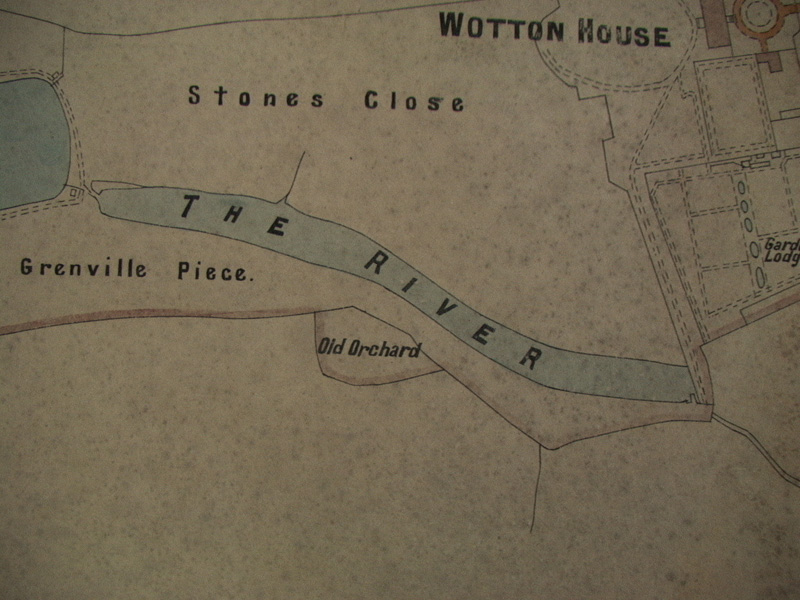
about 1890 map
What
happened to Wotton in modern times?
In
the first half of the 20th century, death duties left the estate
to neglect. In the middle of the century, the estate was sold to
a charity and it later became a boys’ boarding school. Parcels
of land were sold to local farms. The House was derelict by 1957
and Buckinghamshire County Council, who then owned the estate, had
decreed its demolition. Elaine Brunner discovered it and bought
it with the grounds for just £6000, and just two weeks before
demolition was due. She started the restoration, albeit slowly,
given the scale of the task and restrictions on finance. She also
bought back 400 acres of land once part of the estate.
At
her death, in 1988, her daughter April Brunner and her husband David
Gladstone, descendent of the Victorian Prime Minister William Ewart
Gladstone, took over the task. April is no longer with us and David
is planning the succession.
Estate
Manager, Michael Harrison, oversaw much of the gradual restoration
and took great interest in the history and the enormous amount of
work in maintaining the grounds and restoring the features. It was
in the early 1990s that we first met him, and shortly afterwards
David and April Gladstone. We thank them for their help and support
in our own research into the ‘old orchard’ which is
the focus of this account.
|
|
The
Orchard in Modern Times
When we first saw this
orchard it was heavily overgrown and Michael Harrison confirmed
that nothing had been done with it for decades. It had a close
encounter with extinction when Elaine Brunner asked Michael to
clear it. He wisely found more pressing work!
Trees had fallen, roots
had suckered and grown tall and thick, brambles had become widespread
and the shade canopy made proper knowledge of the fruit difficult
at the start. Michael Harrison brought some sanity back, over
time, with extensive clearing of unwanted bramble and rootstock
growth and only judicious pruning. We grafted all the trees at
the outset, to preserve them here and for the future. We passed
back to Michael a new tree of each in the orchard and he planted
them in the spaces of the orchard, for long term continuation.
The orchard is about
½ acre, roughly the shape of a long ellipse, and the uneven
ground is crossed with a depressed channel, probably an ancient
walkway. There are traces of other paths, marking the passage
of relentless feet and the toil of barrows and carts, over countless
years. The landscapers of the gardens were meticulous in their
imposition of flat grounds everywhere, but this did not happen
in the orchard. Another reason to believe it was never part of
the plan. The orchard ground is very uneven.
To the north are the
Gardens and House. To the south is open farmland – now separately
owned and divorced from Wotton Estate. The orchard is ¼
to ½ a mile away from the house and there are no buildings
or gardens close to it for some considerable distance in other
directions. It is alone on the edge of the estate. It is hard
to see why anyone would take any interest in it or replant it.
The absence of any middle aged trees, that could not have come
from re-growth, rootstock growth or random seedlings, leads to
the view that the orchard was frozen in time. Another strong suggestion
for this is that there are significant spaces in the orchard,
where once there would have been fruit trees. Old trees die out,
but why were newer ones not planted to fill the gaps? Long term
lack of husbandry is the compelling conclusion.
The Endicott Pear in
Massachusetts was planted in 1630 and is still alive, with a full
and unbroken history of its existence. Why should we not believe
we might be seeing fruit trees at Wotton of excessive age, even
if not quite as old as 1630?
When first seen there
were 10 apple trees, 5 pears, 7 hazelnuts (of more than one variety),
and a single plum that turned out to be a Blackthorn tree of significant
age, all by itself. One of the pears and two of the hazels have
since died. One apple looks as if it might succumb soon. The gaps
in the orchard might have given space to another dozen or more
trees. This was a mixed domestic orchard from what we see now,
with eating and cooking fruits and space for cider and perry trees,
plus nuts for the winter. We might surmise that some of the missing
trees were cherry and plum, both of which tend not to live as
long as apples, pears and nuts. We have had all the apples and
pears DNA profiled and all except two have come back as unmatched
against any variety in the National Collection. The two that were
matched were a pear ‘Autumn Bergamot’ and an apple
‘Catshead’, both of which have origins by the 17th
century and probably in the 16th century. That so few of the trees
had matches and that there were no 18th or 19th century varieties
found there, speaks volumes.
The pears
could be some of the oldest growing in Britain, while the apples
are surely setting records for the potential age of apple trees.
All the trees fruit, so pollination is still covered within the
orchard. We see that at least some of the trees were grafted,
judging by rootstock growth, and that there were no repetitions
of varieties, possibly excluding the nuts. We do not see the works
of Man in this orchard between the laying out of the Gardens and
the 1990s.
The
Fruits
Pear 1
A small perry pear, ripe in September and very sweet and very
tannic, though the tannin is less if kept for a while and it can
then be pleasant to eat. It does not store for very long. A very
tall, large- trunked and very old tree. Now named 'Wotton Morsel'.
Apple
2
A mature tree possibly 100 years plus and upright. It does not
look as old as the rest. A mature younger shoot from the base
is the same as the rest, from blossom and fruit. Waxy, small,
pale green becoming yellow fruit, with a rare blush and few pale
streaks in the sun, with warm brown russet patches and nets. Fruit
is ripe in October and is fairly crisp, fairly sweet, with pleasant
acid, juicy and tannic. It is possibly a seedling or a sucker
from a tree now gone. It might also be the original variety, shooting
from a decayed trunk. It would probably make a useful single variety
cider apple. Now named 'Wotton Revival'.
Apple
3
A truly ancient tree which fell over many years ago and re-rooted
from the trunk. A new vertical shoot is now mature. The original
trunk when first seen had nearly disappeared into the ground.
Now, the signs of it have almost gone. Some fruit drops in October
but the main drop is in November. Medium to large rounded apples
with matt green skin with light red streaks in the shade but fully
red in the sun. An excellent, crisp, dessert apple, with a complex
flavour when young, becoming richer. At the end of November it
starts to soften but the flavour is good, sweet and juicy. It
will last well until the end of the year. Cooked, it keeps its
shape but would mash and is rich, and sweet, needing no added
sugar. It does not discolour when cut. One of the best in this
orchard and not dated because of antiquity. Michael Harrison has
named this Wotton Prolific as it always bears very well.
Apple
4
A very old tree, fallen over and rooted from the trunk. The vertical
growth is now mature. The old trunk had largely gone in the 1990s.
The fruit is unusual, being irregular, rather flat and very conical
and of variable size, some over 3 inches wide and 2-3 inches deep.
The flesh is sharp and hard, but rich, in October. In November
it is sweeter, still sharp and with a strong flavour. By December
it is perfect – still juicy, rich and sweet but still a
little too sharp to eat raw. Cooked, it keeps its shape well and
is powerfully rich, sweet, very tangy and needs just a little
sugar for perfection. Now named 'Wotton Enigma'.
Apple
5
A fallen tree that had rooted from the trunk. The rootstock had
suckered significantly. A medium sized, flattened, round apple
ripe in October to November. The skin is dull green, and russeted,
becoming amber with a warm blush and a few streaks. In October
it can be a little sharp, but it is also sweet with a good flavour.
It is best in early November when the flesh is tender and juicy.
It will last to December and though it tends to shrink and soften,
it remains sweet, rich and juicy. Now named 'Wotton Resurgent'.
Apple
6
This tree is tall and upright, with a modest girth, though the
trunk is very weathered. It is hard to say if it is a seedling,
a sucker or a new trunk grown from a fallen tree. It looks to
be 100 years or more. This is the latest flowering tree in the
orchard but others are still in flower for pollination. Apples
drop in mid-October and are still intact on the ground in mid-November
and into December. The apples are of variable shape, small and
sweet, without much acidity, a little tannic and a bit dry. They
start pale green and turn greenish yellow with an occasional amber
patch and a few streaks. It might be a useful Bittersweet cider
apple. It is a very prolific cropper and might reveal other qualities
if pruned or grown on a younger tree. Now named 'Wotton Autumn
Carpet'.
Apple
7 and 10
Two ancient trees that had fallen and re-rooted from the trunks,
with several upright re-grown trunks, now old. These two trees
had us (and Michael Harrison) fooled for years. The fruit was
so variable from year to year, and variable on each tree in the
same year, that we all assumed they were the same variety –
the apples of both being large, mainly green turning pale yellow,
heavily ribbed, and both of similar taste and excellence, either
for eating when fully ripe in early November or cooking. Both
trees cropped well, came into flower at the same time and with
seemingly the same blossom characteristics. They seemed to match
what we knew (then) about the long-lost Costards and we named
them ‘Wotton Costard’. (We now know a fair bit more
about Costards and please read our article on this website) We
took cuttings for grafting from Tree 7, as Tree 10 was then ailing
with little new wood. We later grafted Tree 10. This is now close
to death. When we had these Wotton trees DNA profiled we were
not surprised when Tree 7 came back as unmatched. We were surprised
that Tree 10 was Catshead. This now makes sense. It had always
seemed odd to us that such a mixed orchard would have two trees
of the same variety. Now we know why. Tree 7 is Wotton Costard
and Tree 10 is Catshead.
Apple
8
This is a large-trunked, tall and upright tree, first found with
a rash of large suckers at the base, from the rootstock, and bearing
different apples from Tree 8 – so it was clearly a grafted
tree. Whether the tree now seen re-grew from a fallen, broken
or decayed former trunk cannot be ascertained. The apples are
medium sized, roundish and lightly ribbed at the stalk and the
eye. Sometimes there is a little russet on the skin, but usually
the translucent skin is smooth, pale green and with amber red
and maroon streaks. In some years this tree has the habit of producing
ripe apples in mid September and further ripe apples over October.
When gathered they are crisp, juicy, tangy and sweet with a good
flavour, but they do not last long. After a few weeks they become
cidery in flavour and soft. We named this tree ‘Underwood
Pippin’.
Pear
9
This old pear is still upright, healthy and bearing well. It has
enough tannin to mark it out as a perry pear, and is sweet and
juicy too. The tannic flavour tends to fade a bit with storing,
though not enough to make this a good eating pear. Pears are small
and often irregular, becoming ripe in October and lasting a short
while. Though they stay juicy, the flesh becomes mealy. We have
named this tree ‘Duke of Buckingham’ after the long
association between Wotton and the Dukes of Buckingham.
Apple
11
This ancient tree is upright, but is heavily decayed in the trunk
and broken off at 8 feet. A new trunk is growing from the side
of the old trunk, where the limited living tissue is still in
touch with the roots. It is quite a unique apple! The very hard,
bright green fruit is quite inedible until the apples have over-wintered
on the tree and are then gathered in January or February, when
they are best stored for a while longer. The flesh before ripeness
is without sharpness or bitterness and only with a little sweetness.
Eventually, they become sweet, juicy enough and with a good flavour.
As they mature the glossy green skin becomes paler and with some
warm blushes in the sun. Unfortunately, we and Michael have not
been able to test enough apples for long enough, thanks to the
squirrels who make off with them and we do not yet know their
full virtues in cooking at the end of their storing time. In early
February, they keep their shape when cooked with a sweet lemony
flavour. This apple might just be the long lost ‘Deux Ans’
aka ‘John Apple’, known to Shakespeare, as it matches
no other apple, sufficiently described. We can, of course, never
be sure. Now named 'Wotton Endurance'.
Apple
12
The tree is upright, mature and old, but of uncertain age. The
apples are small and the blossom is very attractive. Ripe at the
end of August, into September, the flesh becomes softish a few
days after picking. The flesh is very fruity, juicy, sweet and
crisp straight from tree and would be very good for juicing. Now
named 'Wotton Nectar'.
Pear
13
An ancient pear that fell many years ago onto soft moist ground
and grew new roots from the trunk, flat on the ground. Much of
the old trunk remains, slowly rotting into the ground, while several
new trunks have grown vertically from the old one. Having small
and distinctly rounded, apple-shaped pears, suggested a very old
variety. We named it Capability Pear, for obvious reasons, many
years ago now. The pears are green with variable russet, ripening
to yellowish. In September the fruit is not quite ripe but can
be pleasant to eat, being juicy, sweetish, a little acid and with
a nutty flavour. The flesh is granular and sometimes a bit coarse,
but in October the flesh is softer, sweeter and richer. They do
not last long after that. This tree was DNA profiled by us and
was found to match ‘Autumn Bergamot’ in the National
Fruit Collection, a pear that is certainly 17th century, if not
earlier in origin. Given the matching descriptions for these two
pears, we have accepted Autumn Bergamot to be the correct name
for this pear.
Pear 14
A curious pear! The
tree was ancient and tall when first seen, in excess of 20ft.
The fruit is usually ripe in mid-October, green with russet at
the stalk and eye and sometimes having a mahogany cheek when in
the sun. The pears can be lumpy, irregular and waisted. The skin
is rather like an avocado. The stalk end sometimes produces a
fleshy lip. As the skin turns yellowish, the pears are ripe, but
over-ripe when fully yellow. They decay from the inside out when
fully yellow. The flesh is soft, coarse, granular and slightly
dry but is very sweet with a good flavour. This pear very much
belongs to a bygone age. Now named ‘Wotton Peculiar’.
Pear
15
When first seen, this
ancient tree was leaning and only supported by neighbouring trees
and ivy. The trunk was hollow and the only growth was high up
and sparse. We were able to graft new trees before this pear finally
died a year later. The pears are small to medium sized, a little
irregular and dull green, becoming yellow with a carmine blush
when ripe in late September. The flesh is juicy, sweet and a little
tannic. Now named ‘Wotton Reclaimed’.
Apple
17
This apple is of questionable age and merit. It
is mature and upright – perhaps 100 years old – but
not of the girth of the other old trees. Perhaps it was a seedling
that grew unobserved over the ages or a shoot from a rootstock
that grew to tree size, while its parent tree died and rotted
away. The leaves are small, glossy and rounded while the flowers
barely have any petals to speak of. The bark is different from
other apple trees. It is an odd tree to find there. The fruit
is small, green-yellow, crabby, sharp, tannic and only a little
sweet.
|
|
|
|

